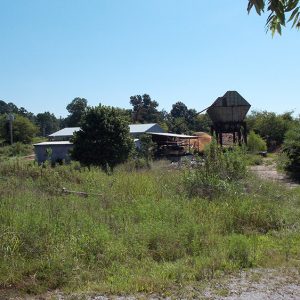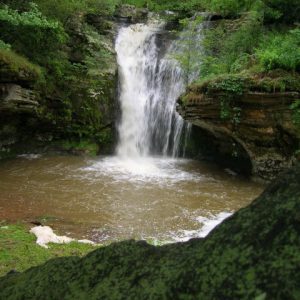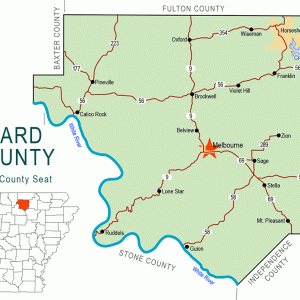calsfoundation@cals.org
Gid (Izard County)
Gid is an unincorporated historic community in Gid Township of Izard County. Gid is located on Arkansas Highway 58 about six miles west-northwest of Mount Pleasant (Izard County), six miles northeast of Guion (Izard County) on the White River, and about six miles southeast of Melbourne (Izard County), the county seat.
The wilderness around Gid served as hunting grounds for the early Native Americans of the area, among them the Osage, Cherokee, and Shawnee. Small game, deer, and bears were plentiful, as were edible wild plants, timber, and caves for shelter.
White hunters and trappers began using the area mainly after the Louisiana Purchase of 1803. An early pathfinder of the area was John Lafferty, who began exploring the region in the early 1800s. Lafferty and his family established the first settlement in what would become Izard County at the mouth of Lafferty Creek on the bank of White River in 1810, where he built a cabin and a trading post.
Gideon Blackburn “Gid” Bruce was born in DeKalb County, Alabama, in 1839, the son of a blacksmith. The family believes he was named for the Presbyterian minister Gideon Blackburn, a famous evangelist of the day. About five years prior to the Civil War, his family moved from Kentucky to the northern part of Independence County. By 1866, he was living on Hidden Creek, where his brother Bill Bruce had settled around 1859.
Gid Bruce served as private in the Missouri Confederate Cavalry, Company A, and he was captured when the Union army in Batesville (Independence County) swept through the area in an effort to gain control of northern Arkansas. He was a prisoner of war from February 1864 until April 1865. Following the war, Gid Bruce and his son Walter owned and operated a blacksmith shop near what became Gid.
Being close to the White River and its ferries, irregulars during the Civil War at times hid out in the hills and caves in the Gid area. Confederate colonel Thomas R. Freeman and his Missouri Cavalry were attacked by Union troops in a skirmish near Gid at Lunenburg (Izard County) on January 20, 1864. On May 16, 2010, as a part of the national Civil War Sesquicentennial observance, a marker was placed near the site of the Skirmish at Lunenburg.
Following the end of hostilities, more settlers began to drift into Hidden Creek to farm and raise livestock. By 1888, when Gid officially became a place name on the map with the establishment of the post office, this growing community between Guion and Melbourne had a store, a grist mill, a cotton gin, a sawmill, a blacksmith shop, and a church. The post office was part of the general store. A stave mill still operates at Gid in the twenty-first century.
The growing community was known as Hidden Creek until 1888, when a group that gathered in the general store disagreed on a name to submit to the U.S. Postal Service for the new post office. Deadlocked and coming close to blows, the self-appointed committee mandated to name it for whomever walked in next. No sooner had they made the decision than Gid Bruce walked through the door. Thus, the Gid Post Office was established on March 23, 1888, with John W. Hanna appointed first postmaster. The Gid Post Office stayed active until 1955, Theodore H. Adkisson being its last post master.
“Uncle Gid,” as he was affectionately known in the community, was killed with his own ax in 1913 during an altercation with a man who intended to marry Gid’s granddaughter against Gid’s wishes. Gid Bruce is buried in Lunenburg Cemetery about three and a half miles west-northwest of Gid. The Campbell-Guion Cemetery and the Reeves-Pine Grove Cemetery are also located close to Gid.
The Gid School was built around the beginning of the twentieth century. In the twenty-first century, the school-age students in the Gid community attend the Melbourne School District. The old school, located on a gravel road, was torn down in the early twenty-first century.
The gristmill at Gid may have been owned by Civil War veteran Ransom Wells Luther (Fifty-Second Pennsylvania Infantry and Sixteenth New York Infantry) and his brother-in-law, a Mr. Scott, who had settled on Lafferty Creek near Gid in 1884, having come from Pennsylvania via Illinois to Arkansas in 1878. The two men first constructed a large sawmill that Luther sold to his brother-in-law, after which he built his own grist mill and cotton gin. The grist mill at Gid was located on a branch about a quarter of a mile before it joins Lafferty Creek.
One of the earliest roads in the county connected the steamboat landing and later the railroad at Wild Haws Landing (Guion) to Melbourne and the central part of the county.
At first, Gid was blessed by its location along the beaten path, but changes in transportation and communication by the mid-twentieth century allowed it to be overshadowed by Melbourne. The nearby river town of Guion is home to the state’s largest underground industrial sand mines, which have saved Guion from virtual extinction.
Located in a beautiful if somewhat isolated region of the Ozarks, Gid benefits from natural attractions such as caves and waterfalls, although most of these attractions are located on private property with limited access. The Gid Waterfall, which spills thirty feet into the creek below, is perhaps the best known. About a mile away from the Gid Waterfall is the Gristmill Waterfall, where the 1880s-era gristmill stonework remains can be found. The old Indian cave near Gristmill Waterfall is perhaps the best known of the caves in the area.
A noted song written about the gristmill, called “Little Johnny Lee,” was composed in 1886 by the Reverend John Crafton, who was the first pastor of the Freewill Baptist Church just down the road from the site of the mill. The folk ballad is about the death of a boy, Johnny Lee, who, along with a neighbor, Nathan Bailey, journeyed home from the mill in a brutal winter storm of February 1886, having been sent to the mill by Johnny’s father. Johnny Lee, the younger of the two, died of exposure at Coleman’s Lane on the way home.
For additional information:
Biographical and Historical Memoirs of Izard County, Arkansas. Chicago: Goodspeed Publishing Co., 1889.
Cooper, William Bud. “The Civil War in Izard County, 1861–65.” Izard County Historian 33 (January 2008): 10–14.
Hammett, Charles. “Civil War Skirmishes in Izard County.” Izard County Historian 7 (April 1976): 25–34.
“Killed With an Ax.” Melbourne Times, August 14, 1913.
“Little Johnny Lee.” Sung by Mrs. Ben Johnson, Recorded in Cave City, Arkansas, August 27, 1957. John Quincy Wolf Folklore Collection. Lyon College, Batesville, Arkansas.
Shannon, Karr. A History of Izard County. Little Rock, AR: Democrat Printing and Lithographing Company, 1947.
Stowers, Juanita. The History and Families of Izard County, Arkansas. Paducah, KY: Turner Publishing Company, 2001.
Kenneth Rorie
Van Buren, Arkansas
 Civil War Sesquicentennial
Civil War Sesquicentennial Gid Stave Mill
Gid Stave Mill  Gid Waterfall
Gid Waterfall  Izard County Map
Izard County Map  Old Tate Store
Old Tate Store 



Comments
No comments on this entry yet.